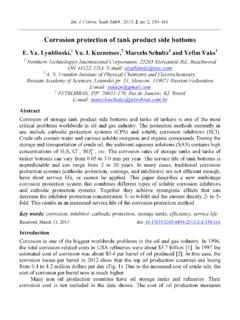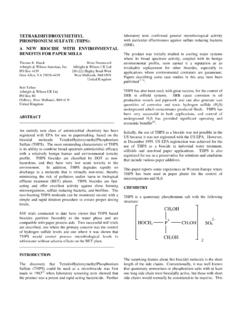Transcription of Laboratory assessment of tetrakis(hydroxymethyl ...
1 Int. J. Corros. Scale Inhib., 2015, 4, no. 3, 235 254 Laboratory assessment of tetrakis( hydroxymethyl ) phosphonium sulfate as dissolver for scales formed in sour gas wells Q. Wang,1* S. Shen,1 H. Badairy,1 T. Shafai,1 Y. Jeshi,1 T. Chen2 and F. F. Chang2 1 Saudi Aramco, Research and Development Center, Dhahran, Saudi Arabia 31311 2 Saudi Aramco, EXPEC Advanced Research Center, Dhahran, Saudi Arabia 31311 *E-mail: Abstract Tetrakis( hydroxymethyl ) phosphonium sulfate (THPS) is an environmental friendly biocide commonly used in oil fields.
2 It also has been used to control iron sulfide precipitation for water injection and to remove deposits in oil production systems. In this study, THPS was examined as the dissolver for scale deposits formed on downhole tubular of high temperature sour gas wells. These deposits consisted of a wide range of mineral phases and are often dominated with various forms of iron sulfides and iron oxyhydroxides. The THPS based dissolvers were studied at various concentrations, pH values and with different additives. These additives included ammonium chloride, chelating agents and phosphonates.
3 Experimental results indicated that the dissolving power was not proportional to THPS concentration. The maximum dissolution was observed in THPS concentration of 25 to 50%, depending on scale composition. Its dissolving power could be significantly increased with both ammonium chloride and chelating agents. The synergistic effect of ammonium chloride was largely attributed to pH decrease. As a result, the corrosivity of THPS solution to metallurgy was increased with the addition of ammonium chloride.
4 The corrosion rate of mild steel was increased over three times with 4% ammonium chloride added. Contrary to previous reports, phosphonate additives decreased scale dissolution and induced new precipitation. Formation of calcium sulfate precipitates was also observed during dissolution of calcite, which will limit the THPS from scales containing calcium carbonate. This study also revealed the dissolution behavior of different minerals in the THPS solution. Iron oxyhydroxides had the highest dissolution rate, followed by calcite, siderite and pyrrhotite.
5 Pyrite, marcasite and anhydrite were almost insoluble in the tested solutions. Results from this study can be used as guideline for the development and design of THPS based scale dissolvers. Keywords: iron sulfide, iron scale, scale dissolver, THPS, gas well. Received: June 8, 2015 doi: Int. J. Corros. Scale Inhib., 2015, 4, no. 3, 235 254 236 Introduction Tetrakis( hydroxymethyl ) phosphonium sulfate, commonly referred to as THPS, is a commercial product in organophosphine derivatives.
6 Flame retardant for cotton and viscose fabrics is one of the most important uses of this product [1, 2]. It is also applied in hydrometallurgical extraction and leather tanning processes, for curing of epoxies, in phase transfer catalysis, and for preservation of coatings, pigments and slurries [3, 4]. In the oil and gas industry, THPS is primarily utilized as a biocide to control sulfate reducing bacteria due to its enhanced performance, higher thermal stability and low foaming potential [5 8]. Unlike conventional biocides, which are highly toxic to aquatic organisms and accumulative in the food chain, THPS has a relatively good environmental profile [8, 9].
7 It can be degraded in both aerobic and anaerobic environments through hydrolysis, oxidation, biological and photo reactions [10]. The degradation reactions are affected by many factors such as temperature, pH value, O2 level, light, microbes and the presence of mild steel [10, 11]. The breakdown products include trishydroxymethylphosphine oxide (THPO), bishydroxymethyl phosphonic acid (BMPA), and possibly a formaldehyde adduct of trihydroxy compound [12]. These compounds have low aquatic toxicity and are not considered as environmental hazard.
8 While used primarily as a biocide, THPS was also found being able to dissolve iron sulfide precipitates. Talbot et al. [13] studied the dissolution of iron sulfides in THPS based solutions over a range of conditions and showed that its performance was comparable to or even better than the uninhibited hydrochloric (HCl) acid with actual field scale samples as well as pure authigenic minerals, particularly in combination with ammonium chloride or organic phosphonate scale inhibitor. In their study, the THPS also displayed an ability to dissolve pyrite, which is generally considered insoluble in hydrochloric acid [14].
9 Wylde and Winning [15] further investigated the dissolution properties of THPS solutions and evaluated different additives for synergistic effects using both static and dynamic dissolution testing procedures. They also concluded that the THPS blended dissolver performed at least as well as, and in some cases better than the HCl acid. It is obvious that the aforementioned study results could be affected by many factors, such as test temperature, duration, scale to dissolver ratio and scale composition. Differing from other types of scale, both iron and sulfide have multiple redox states and, depending on the formation conditions, they can form precipitates with various compositions and dramatically different properties [16].
10 The identified scale minerals in petroleum industry include mackinawite (FeS) and pyrrhotite (Fe1 xS), troilite (FeS), greigite (Fe3S4), and iron disulfide pyrite and marcasite (FeS2) [17 19]. Each mineral has its distinct reactivity toward the dissolver. In addition, grain size, shape and the distribution of scale particle also affect their dissolution behaviors. Deposits may contain non-sulfide components such as carbonate, oxide and sulfate minerals. An efficient scale dissolver must be effective to all minerals under field application conditions.






